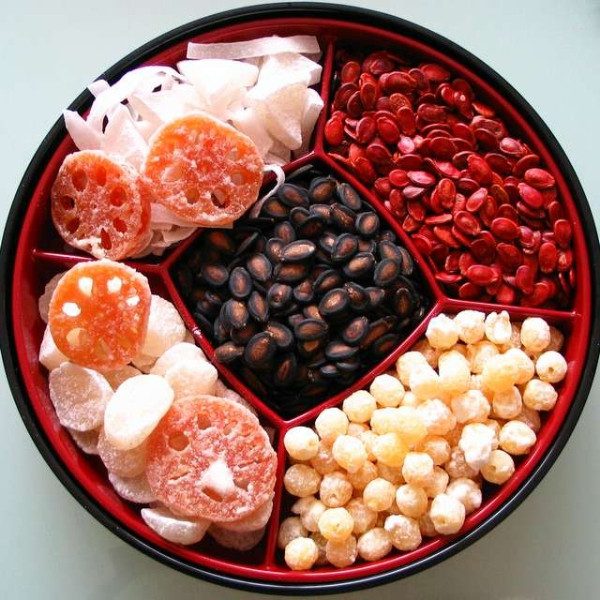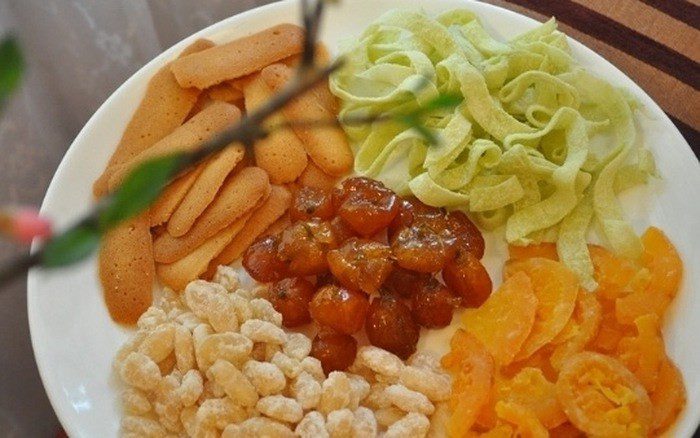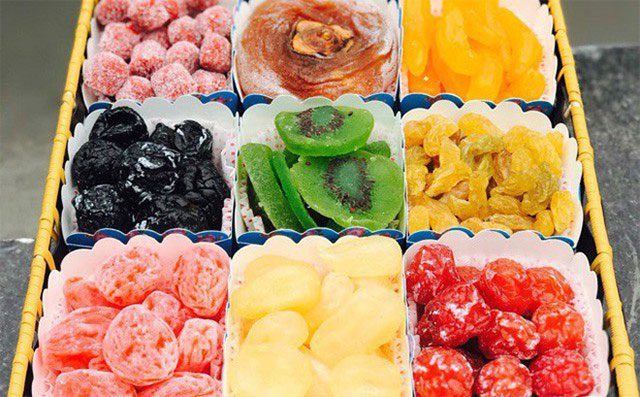Fruit preserves are a traditional delicacy in Vietnam, representing not just a material aspect but also a spiritual connection. While fruit preserves have some benefits, should we consume them in large quantities?
The Truth About Tết Preserves You Should Know
Tết preserves are a traditional Vietnamese dish that embodies the essence of cultural heritage. A quality box of Tết preserves should feature around ten different flavors, harmonious colors, and eye-catching packaging. But have you ever wondered how much nutritional value is in that box of preserves?
Initially, preserves were made from common fruits in Vietnam such as winter melon, coconut, apples, bananas, ginger, and calamondin. However, with technological advancements and market demands, today we can easily find a variety of unique preserves, including those made from sweet potatoes, winter melons, tomatoes, and fruits like persimmons, peaches, pears, tamarind, plums, apples, strawberries, and kiwis. According to Dr. Nguyễn Thị Lâm, former Deputy Director of Nutrition, preserves contain many beneficial components for the body, such as carbohydrates, proteins, organic acids, vitamins, and minerals, as well as antioxidants. Notably, they also contain phytochemicals that help protect against cell oxidation, enhance liver function, and detoxify the body.
- Ginger preserves: help warm the stomach, prevent vomiting, detoxify, and treat coughs.
- Calamondin preserves: cool the body, stimulate digestion, relieve phlegm, prevent vomiting, and detoxify alcohol.
- Lotus seed preserves: have a calming effect, reduce stress, and combat fatigue.
- Persimmon preserves: help combat fatigue, treat coughs, and alleviate nocturia.
- Sweet potato preserves: promote bowel movements and prevent constipation.
- Coconut preserves: aid digestion.
- Tamarind preserves: quench thirst, stimulate digestion, and promote bowel movements.
- Tomato and carrot preserves: help improve eyesight, enhance skin health, and reduce the risk of prostate cancer.

Tết preserves are a traditional dish in Vietnam.
1. How many calories do Tết preserves have? Will eating them make you gain weight?
Tết preserves are a delicious treat that we can enjoy throughout the day with a hot cup of tea during the Tết holiday. However, many people worry that eating Tết preserves may lead to rapid weight gain. Is this true? First, let’s find out how many calories are in Tết preserves!
According to research, the calorie content of Tết preserves depends on the ingredients used. Below are the calorie counts for some types of Tết preserves you can reference.

Calorie count in various types of preserves.
From the calorie chart of the various preserves, it can be seen that the calorie content of Tết preserves is not excessively high compared to daily energy needs. However, this does not mean that eating Tết preserves won’t lead to weight gain!
You should consume Tết preserves in moderation, avoiding excessive amounts at one time, and incorporate other nutrient-rich foods to balance your daily intake. Additionally, for those on a diet or looking to lose weight, it is advisable to choose low-calorie preserves and consume them in moderation!
2. Decreased Nutritional Value
Fruits naturally contain various vitamins and minerals that are beneficial for health. However, through high-temperature processing and extended cooking times, these nutrients can be altered or lost.
For example, tomatoes, carrots, apples, and plums have high levels of vitamins A and C, but the effects of heat can cause them to be completely lost. Thus, sometimes the preserves that reach us are merely “shells without souls” – retaining their flavor and color but lacking nutritional value.
3. Excessive Sugar Content
According to Dr. Nguyễn Văn Tiến from the Center for Nutrition Education and Communication, preserves made from ingredients like winter melon and coconut contain a lot of sugar, which can cause a rapid increase in blood sugar levels. It is recommended to consume only (1-2 pieces per day).
The recipe for preserves typically includes a significant amount of sugar, as sugar helps to neutralize bitter and sour flavors, making the final product more palatable and prolonging its shelf life.
However, sugar primarily provides energy for the body without delivering substantial nutrients, so frequent consumption of preserves can lead to nutrient deficiencies. Furthermore, the high sugar content in preserves is one of the “culprits” that can cause weight gain after the Tết holiday.

Diabetics and those with high blood sugar should limit their consumption of preserves.
4. Can Cause Bloating
Consuming a lot of preserves can also lead to bloating, reducing your appetite. Consequently, this may lead to eating less during main meals, which means your body may not receive enough essential nutrients.
5. Who Should Limit Their Consumption of Preserves
Due to the sugary nature of preserves, they are very sweet, and those who are overweight should avoid them. Consuming too many can lead to a decrease in intake during main meals, resulting in fatigue as the body only receives energy from sugar, lacking proteins, fats, vitamins, and minerals.
Individuals with diabetes or high blood sugar should also limit their intake of preserves to prevent worsening their condition. Pregnant women, the elderly, and young children should also consider their consumption of preserves. Enjoy them in moderation to savor the Tết flavors without encountering health issues.
Due to their high sugar content, preserves primarily generate energy and do not provide enough nutrients, especially vitamins and minerals, compared to when the fruits were fresh. Therefore, they are not suitable for the elderly, children, and pregnant women throughout their pregnancy; they should not be consumed in large quantities or as a substitute for other foods.
In summary, preserves remain an irreplaceable spiritual gift during the Tết season. However, when selecting Tết preserves for family and friends, hygiene and food safety should be a top priority. Choose products from reputable brands with complete information, including production and expiry dates.
6. How to Store Tết Preserves

Tết preserves often contain a lot of sugar, so they should be stored in a dry, cool place.
To keep Tết preserves fresh for a longer time, store them in a glass jar and cover them with a layer of white sugar on top. This will help retain their original aroma and prevent them from becoming watery, as the sugar layer absorbs moisture.
Tết preserves should be stored in a dry, cool place, avoiding direct sunlight and hot areas that can cause them to become watery, soft, and lose their crispness.
Never store preserves in the freezer, as taking them out for use can ruin them. They may become watery when exposed to the environment, allowing bacteria to enter and potentially cause food poisoning.
For opened packages of preserves, be sure to seal them tightly after use. Avoid mixing leftover preserves with unopened packages to prevent spoilage.
7. Be Mindful of the “Three No’s of Tết Preserves”
Every year, as Tết approaches, discussions about candies and preserves become lively. This category of products is highly diverse, making it challenging for authorities to control their types, origins, and quality.
The health risks posed by products that do not meet food safety standards, whether imported from China or produced in unsanitary small-scale facilities, raise concerns among consumers. These products may use prohibited additives in soaking, marinating, or creating eye-catching colors, which can be harmful to health.
“Three No’s of Tết preserves” may not meet food safety standards. (Illustrative image).
Although authorities and market experts have been actively coordinating to strictly inspect Tết preserves, the reality is that “three no’s preserves” (no labels indicating source, no production dates, no expiry dates) still infiltrate the market and are sold everywhere.
These types of preserves pose a risk of not meeting food safety standards, often produced in small facilities where raw materials are exposed to dust and unsanitary containers are used for soaking the preserves. Additionally, they may contain prohibited additives such as bleaching agents, colorants, artificial sugars, and borax, all of which may be harmful to health.
Some production facilities are unhygienic, which can lead to bacterial contamination and the emergence of certain gastrointestinal diseases, such as diarrhea caused by infection. The improper preservation process can easily lead to mold growth, which poses more harm to health than benefits.
Therefore, if not too busy, each family can prepare traditional jams for the Lunar New Year themselves, ensuring food safety while retaining the flavors of the holiday. This also gives the women a chance to showcase their culinary skills and creativity. Alternatively, mothers should choose jams from Vietnam that are produced by reputable companies, with proper branding, labels, production dates, and expiration dates.
- Visit famous traditional Tet jam-making villages in Vietnam
- 5 delicious dishes to avoid eating with jam
- The truth about the type of nut many families display in their Tet jam trays: Why is it the most expensive in the world?
- The significance of traditional Vietnamese cakes during the Lunar New Year
- Every Tet, the color red becomes popular, but do you know why?


















































